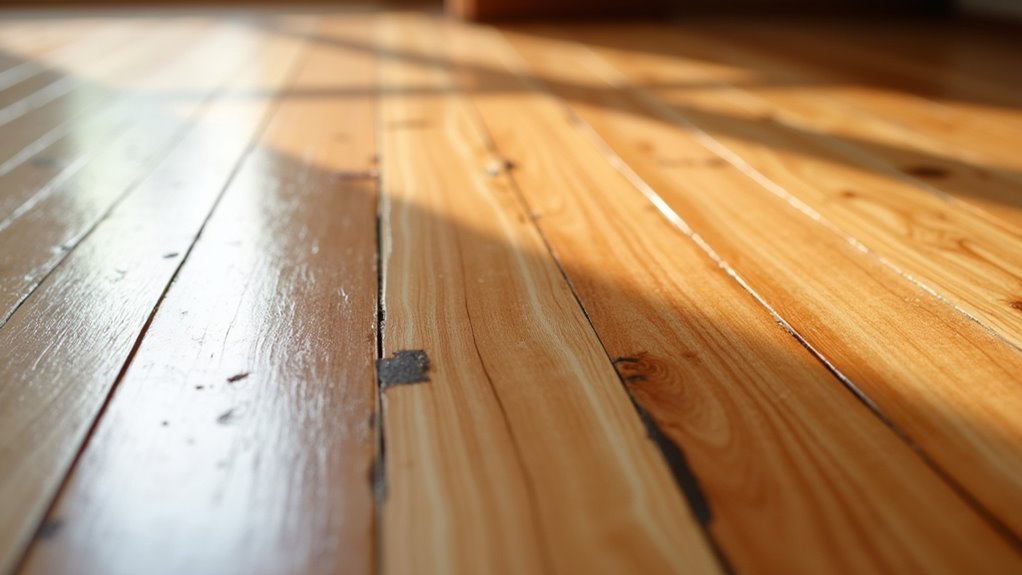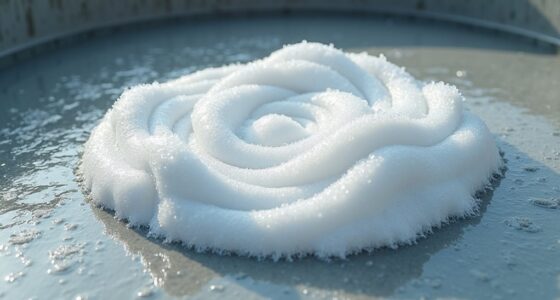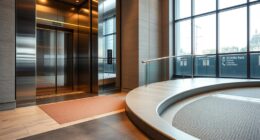Using too much water or harsh cleaning tools can easily damage sealed hardwood floors. Avoid over-wetting with excessive water or stiff brushes that scratch the surface. Instead, opt for damp microfiber cloths or well-wrung mops with gentle, pH-neutral cleaners. Regular sweeping prevents debris that can cause scratches. By following simple fixes like these, you’ll protect your floors’ finish and maintain their beauty for years to come—there’s more to discover for better results.
Key Takeaways
- Using stiff-bristled brushes or steel wool can scratch the sealed surface; switch to soft microfiber pads for gentle cleaning.
- Applying excessive water or leaving floors too wet can cause damage; always use damp, well-wrung cloths or mops.
- Using harsh or chemical-based cleaners can dull the finish; opt for pH-neutral, hardwood-specific cleaning products.
- Over-waxing or applying too many cleaning products leads to buildup; use minimal products and buff lightly to restore shine.
- Neglecting regular sweeping or vacuuming allows debris to scratch the surface; clean floors frequently with a soft broom or vacuum attachment.

Sealed hardwood floors are durable and low-maintenance, but using the wrong cleaning methods can cause damage. Many people overlook this and end up making common maintenance errors that compromise the finish and longevity of their floors. To avoid these pitfalls, it’s essential to understand proper cleaning techniques and recognize mistakes that could harm your hardwood.
One of the most frequent errors is using excessive water or wet mops. While it might seem like a good idea to clean thoroughly, too much moisture can seep into the seams and cause the wood to swell or warp. Instead, you should use a damp microfiber cloth or a well-wrung mop that barely leaves any liquid behind. This ensures dirt lifts without saturating the surface, helping you keep your floors looking pristine without risking water damage.
Avoid excessive water; use a damp cloth or well-wrung mop to protect your hardwood floors.
Another common mistake involves using harsh cleaning products or abrasive tools. Many think that strong chemicals or steel wool will remove stubborn stains, but these can scratch or dull the finish. Proper cleaning techniques involve gentle, pH-neutral cleaners designed specifically for hardwood. Always read labels carefully and test a small, inconspicuous area first. Avoid using steel wool or stiff-bristled brushes, as they can leave scratches that are difficult to repair.
People also tend to forget about regular sweeping or vacuuming, which is crucial for maintaining the appearance of sealed hardwood floors. Dirt and debris act like sandpaper, gradually wearing down the surface if left unchecked. By consistently removing surface grit with a soft-bristled broom or a vacuum with a hardwood floor attachment, you prevent scratches and keep your floors looking newer longer.
Many homeowners make the mistake of over-waxing or using too many cleaning products, which can build up over time and create a dull film on the surface. Proper cleaning techniques involve using minimal product, just enough to clean effectively, and then wiping away any excess. If your floors start to look dull, a professional buffing or a specialized floor cleaner can restore their shine without the need for additional wax layers.
Frequently Asked Questions
Can Using Too Much Water Damage Sealed Hardwood Floors?
Yes, using too much water can cause water damage to your sealed hardwood floors. Excessive moisture seeps into the seams and beneath the finish, potentially warping or cupping the wood over time. To prevent this, avoid leaving puddles or using overly wet cleaning tools. Instead, use a damp mop and dry the floor thoroughly afterward. Proper care guarantees your hardwood remains beautiful and damage-free.
Is Vinegar Safe for Cleaning Sealed Hardwood?
Vinegar cleaning is like using a gentle rain on your hardwood floors—safe if done right. It’s a natural disinfectant that effectively cleans sealed hardwood, but you should dilute it properly to avoid damage. Straight vinegar can wear down the finish over time. Mix it with water, and you’ll have a safe, eco-friendly solution that restores shine without harming your floors. Always test a small area first!
How Often Should I Scrub Sealed Hardwood Floors?
You should mop your sealed hardwood floors about once a week to prevent dirt buildup. Over-mopping can damage the finish, so stick to this routine to keep your floors clean without risking wear. If you notice more dust or dirt, increase the frequency slightly, but avoid excessive scrubbing. Regular, gentle cleaning helps maintain your floors’ appearance and longevity, ensuring they stay beautiful for years to come.
What Type of Scrubber Is Best for Sealed Hardwood?
You should choose a soft-bristled scrubber or a microfiber pad for sealed hardwood floors. These types of scrubbers effectively clean without damaging the finish. Avoid harsh scrubber materials like steel wool or abrasive pads, as they can scratch or dull the surface. Use gentle, circular motions with the appropriate scrubber types, and always follow up with a damp cloth to remove residue and protect your hardwood’s shine.
Are There Specific Cleaning Products to Avoid on Sealed Floors?
Like a knight facing a dragon, you should avoid harsh chemicals and abrasive tools on sealed floors. These can damage the finish and cause scratches. Stick to pH-neutral cleaners and soft microfiber mops, just like a gentle squire. Harsh chemicals can strip the sealant, while abrasive tools scratch the surface. Always read labels and test in a small area first to keep your hardwood looking pristine and protected.
Conclusion
So, here’s the irony: you’d think cleaning sealed hardwood would be simple, but those tiny mistakes can turn your pristine floors into a scratched-up mess. Just remember, a little caution goes a long way—don’t over-wet, use the right cleaner, and avoid heavy scrubbing. After all, your beautiful floors deserve a gentle touch, not a harsh scrub. It’s almost funny how doing less actually keeps them looking their best. Happy cleaning!









